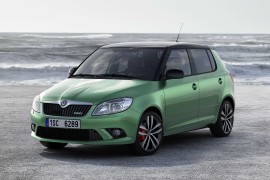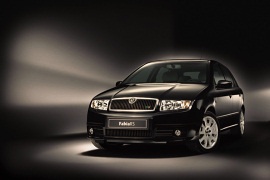SKODA Fabia RS Models/Series Timeline, Specifications & Photos
First production year: 2003
Engines: Gasoline, Diesel
Body style: Hatchback
Skoda introduced the facelifted version of the Fabia's second generation at the 2010 Geneva Motor Show, and at the same time, it revealed the sporty version RS.
Aiming at the supermini hot-hatch segment, the Czech brand's fans eagerly awaited this version. While the first generation of this nameplate was offered only as a turbo-diesel, the 2010 model came with a turbocharged gasoline engine that made its customers sign order books. It was not only one of the most affordable hot hatches on the market but it was also packed with technology and amenities.
Like the rest of its siblings, the RS version showed a front fascia with wide headlights swept back on the sides. In addition, it featured standard Xenon headlights and a different front bumper that sported an A-shaped lower grille flanked by two fog lamps. As an option, customers could choose a contrast-color roof to make the car looks sportier. In addition, its 17" light-alloy wheels were unique for the RS version. Finally, at the back, the tailgate was adorned with a roof spoiler, and a twin chromed exhaust completed the image at the lower part of the bumper.
Inside, Skoda ditched the regular bucket seats offered for the rest of the Fabia range and installed high-bolstered ones for the front occupants. In addition, the three-spoke steering wheel received an RS badge. Since the RS was the highest-powered version of the Fabia and the most expensive in the lineup. As a result, it was packed with more standard features, such as an upgraded infotainment system and better upholstery.
For the drivetrain, Skoda installed a 1.4-liter turbocharged powerplant carried over from its cousin, Volkswagen Polo GTI. It paired it with a seven-speed automatic (dual-clutch) gearbox that drove the front wheels.
Skoda introduced the Fabia lineup in 1999, but only four years later, it brought the most potent version into its lineup, stirring emotions in the small hot hatch segment.
The Czech automaker tried to get into the World Rally Championship with a smaller, lighter vehicle than the Octavia, so it focused on the small-sized Fabia. But there was a problem: the car was shorter than the mandatory rules, and, in addition, it didn't tick all the boxes it required for the drivetrain. Moreover, Skoda wanted a model that could gather more customers from the younger generation.
While the FIA regulations stipulated the car's length, they didn't specify how that could be attained. Thus, the carmaker created slightly fatter bumpers, both front, and rear. Therefore, the end result was 3 mm (0.12") more extended bodywork than the minimum 4.0-meter (157.48") required by the motorsports governing organization. That led to a redesigned apron, which included two fog lamps in the outer scoops flanking the squared lower grille. Moreover, at the back, the rear bumper sported an extended apron with a cutaway for the RS-specific chromed exhaust tip.
Inside, Skoda installed high-bolstered front seats with black and gray upholstery adorned on the seatbacks with the RS logo. Furthermore, the Fabia RS featured aluminum pedals to create an even sportier atmosphere. Inside the instrument cluster, the carmaker placed redesigned black and white dials and red needles.
Underneath the hood, the Fabia RS received a 1.9-liter turbo-diesel powerplant from Volkswagen. The engine developed 130 PS (128 HP) and 310 Nm (229 lb-ft) of torque, sent to the front wheels via a six-speed manual transmission.

